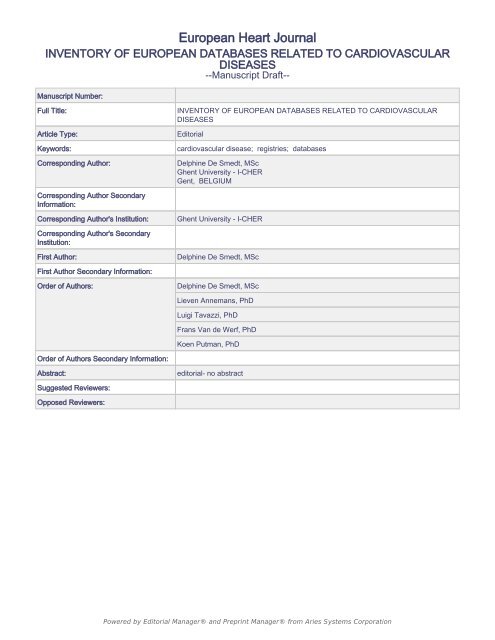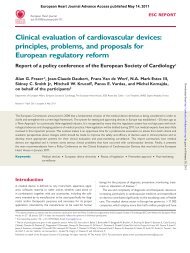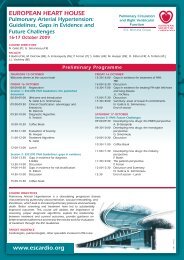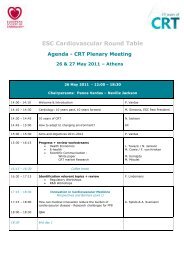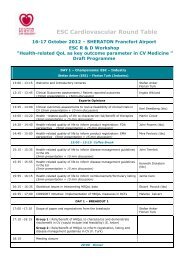Editorial - Cardiovascular Round Table (CRT)
Editorial - Cardiovascular Round Table (CRT)
Editorial - Cardiovascular Round Table (CRT)
Create successful ePaper yourself
Turn your PDF publications into a flip-book with our unique Google optimized e-Paper software.
European Heart JournalINVENTORY OF EUROPEAN DATABASES RELATED TO CARDIOVASCULARDISEASES--Manuscript Draft--Manuscript Number:Full Title:Article Type:Keywords:Corresponding Author:INVENTORY OF EUROPEAN DATABASES RELATED TO CARDIOVASCULARDISEASES<strong>Editorial</strong>cardiovascular disease; registries; databasesDelphine De Smedt, MScGhent University - I-CHERGent, BELGIUMCorresponding Author SecondaryInformation:Corresponding Author's Institution:Ghent University - I-CHERCorresponding Author's SecondaryInstitution:First Author:Delphine De Smedt, MScFirst Author Secondary Information:Order of Authors:Delphine De Smedt, MScLieven Annemans, PhDLuigi Tavazzi, PhDFrans Van de Werf, PhDKoen Putman, PhDOrder of Authors Secondary Information:Abstract:editorial- no abstractSuggested Reviewers:Opposed Reviewers:Powered by <strong>Editorial</strong> Manager® and Preprint Manager® from Aries Systems Corporation
Letter to the EditorThomas F. Lüscher,Editor-in-Chief,European Heart Journal,Dear Professor Thomas F. Lüscher,Enclosed for your consideration as an editorial or a current opinion (we would like to leave this decisionup to the editorial board) in the European Heart Journal please find our paper entitled “Inventory ofEuropean databases related to cardiovascular diseases”. The paper has been written following theinitiative of the <strong>Cardiovascular</strong> <strong>Round</strong> <strong>Table</strong> (ESC) to develop and launch an inventory of existingcardiovascular registries.Please do not hesitate to contact me, should you have any questions. Thank you for your considerationand I look forward to hearing from you.Yours sincerely,Delphine De SmedtOn behalf of all the authors
Manuscript1234567891011121314151617181920212223242526272829303132333435363738394041424344454647484950515253545556575859606162636465Title:Inventory of European databases related to cardiovascular diseases.Authors:Delphine De Smedt, MSc 1,2 ; Lieven Annemans, PhD 1,2,3 ; Luigi Tavazzi, MD, PhD 4 ; Frans Van deWerf, MD, PhD 5 ; Koen Putman, PhD 2,31 Department of Public Health, Ghent University, Gent Belgium2 Interuniversity Centre of Health Economics Research, Gent/Brussel, Belgium3 Faculty of Medicine and Pharmacy, Vrije Universiteit Brussel, Brussel, Belgium4 GVM Care and research, Maria Cecilia Hospital, ES Health Science Foundation, Cotignola,Italy5 Department of <strong>Cardiovascular</strong> Medicine, University Hospitals Leuven, Leuven, BelgiumAcknowledgmentThe registries inventory and web-based dynamic portal project was developed with assistance ofMs Florence Bakry, coordinator of the ESC <strong>Cardiovascular</strong> <strong>Round</strong> <strong>Table</strong>.Word Count=1500
1234567891011121314151617181920212223242526272829303132333435363738394041424344454647484950515253545556575859606162636465Despite the recent decline in cardiovascular disease (CVD) death rates in some WesternEuropean countries, CVD remains the main cause of morbidity and mortality throughout Europewith more than 4.58 million deaths in 2008 (1;2). On average 31% of life years lost are causedby CVD (2). Besides the large health burden, CVD causes also a major economic burden. Thedirect health care costs are estimated to account for almost 10% of health care costs in the EU(€110 billion in 2006) (2). About 54% of these costs can be attributed to inpatient hospital care,and 28% are due to drug use. In addition, productivity losses and informal care (i.e. theopportunity cost of unpaid care given by family members or friends) greatly contribute to theoverall financial burden of CVD, amounting to -in 2006- about €41 billion and €42 billionrespectively. Hence, there is a need for ongoing improvements in cardiovascular diseasemanagement. Allender et al. (2008) also reported on the huge regional differences in prevalenceof both cardiovascular risk factors and CVD events across European countries stressing theneed for better organised CVD management (2).A prerequisite to good disease management lays on the quality of the available data.Indeed, as stated in the ESC EHN white paper on “The development of a centralisedcardiovascular data collection across the EU member states”, high quality data are indispensiblein order for health care providers and policy makers to make appropriate decisions (3).Randomised clinical trials (RCTs) are essential in defining the treatment effect and targetingsafety issues (4;5). However due to their inclusion/exclusion criteria, strict protocol instructionsand limited timeframe, RCTs lack external validity and applicability to real life situations (4-6).Registries are large observational databases with the advantage of containing real life data onan entire spectrum of patients, including higher risk patients such as elderly or patients with comorbidities,who are often excluded from RCTs. Therefore, registries can help in the evaluationof RCT results in daily practice. They have the additional advantage that data can be collectedon large number of patients within a limited time frame, especially when multiple centrescooperate, offering a comprehensive picture of variety in clinical practice. If well designed, thedata allows to collect information on prevalence, incidence, treatment and progress of a specificdisease for a representative sample. Whereas rare adverse events are sometimes not observedin trials, they are often well noticed in those registries with longitudinal follow up making themideal for post marketing surveillance. In addition, registries can serve as an ideal tool to collectinformation on resource use and to identify treatment patterns. Therefore they can be useful tocalculate cost-of-illnesses or the costs of treatment modalities. Cost data are an important asset,given the current era where cost-effectiveness is increasingly needed. Likewise, data on qualityof life and absenteeism from work can be easily collected. Another asset of registries is their
1234567891011121314151617181920212223242526272829303132333435363738394041424344454647484950515253545556575859606162636465possibility to identify significant differences in care, allowing benchmarking between clinicians,regions or even countries. This would facilitate clinical practice improvements and support healthpolicy decision-making. Finally, the massive amount of information provides additional sourcesof information in developing guidelines which are important for establishing the best suitabledisease management strategies.In Europe, the existing registries are highly heterogeneous, dispersed, and often not structured.This prevents easy comparison between countries. There is a need for a centralised uniformEuropean CVD registry, providing a solution to the dispersion and heterogeneity of data andallowing assessment of quality of care and patient outcomes in a more consistent manner (3).Ideally, such a centralised collection of CVD data will also make the bridge with epidemiologicdata, which will enrich the registries with more real life data, in particular on patients who are nothospitalised. Epidemiology data will give valuable information on the prevalence of the diseaseand risk factors to only list a few.The European Union is showing a growing interest in the centralization and standardization ofhealth data. EU Member States are currently working on the implementation of the Directive onCross Border Healthcare, which implies the exchange of health data from one EU country toanother. A consensus needs to be found between nations on the standardisation of the collecteddata. As a matter of fact, the current situation where most Member States have developed theirown data collection systems results in many well know and sometimes unknown national andeven regional registries, which need to be connected to each other.The SWEDEHEART registry in Sweden is a good example of how different existing registriescan be merged into one new registry, allowing longitudinal follow up of each patient included(based on the unique identification numbers). SWEDEHEART merges four registers,respectively on intensive care admissions (RISK-HIA), on heart surgery, on percutaneouscoronary intervention and coronary angiography (SCAAR), and on secondary prevention(SEPHIA) and leads to a reduction of workload for clinicians (7).In order to have a general overview of the available CVD data in Europe and in individualEuropean countries, the ESC took several initiatives. Firstly, to coordinate the implementation ofmultinational registries dealing with several epidemiologically important CVD areas. Presently 6registries are ongoing and 4 will be implemented in 2012. Secondly, to build an inventory of theexisting registries, which was initiated by a project team on "Health Economics" set up by the<strong>Cardiovascular</strong> <strong>Round</strong> <strong>Table</strong> of the ESC. Identification of registries was organised in different
1234567891011121314151617181920212223242526272829303132333435363738394041424344454647484950515253545556575859606162636465ways. To start, the national Cardiology Societies associated to the ESC were asked to provide alist of registries performed in their countries. Then, a systematic search was conducted in bothstructured peer-reviewed databases such as Medline and through hand search in the referencelist of all selected papers to complete the list. Finally, a grey literature search was done to lookfor missing registries. Regional, national, as well as multi-country registers were considered inthe inventory. A questionnaire was sent to the registry holders to collect information on thepopulation included, the pathologies/indications covered and the availability of clinical, healtheconomic and quality of life data.The inventory provides a comprehensive overview of the databases throughout Europe, andhence to identify the gaps related to countries, diseases, and other CVD data. As a result a webbasedroutinely updated dynamic portal was set up and can be consulted at http://www.esccrt.org/Pages/dynamic-portal.aspx.The aim of this portal is to offer cardiologists,epidemiologists, policy makers, health economists, the industry, patient groups and otherstakeholders an overview of existing databases. The interactive portal is designed as such thatone can perform search based on country, pathology or intervention, accessibility, resource useand quality of life. A list of registries complying with the search criteria is generated. For eachregistry a brief description and the contact details of the registry holder is available.Currently 260 registries are included in the inventory of which 194 are accessible, publicly orupon request. 252 registries contain some kind of information on resource use, like informationon hospitalization, medication use, lab test use, imaging techniques or medical devices. 80%contain info on the clinical diagnosis. Longitudinal follow-up data and mortality data are availablein 76% of the databases. 64% of the databases are CVD specific whereas the others containCVD data but also data related to other diseases. Only 29% contain info on patient quality of lifeand about 50% of the databases had some kind of quality control system or audit. For mosttopics only one or a few databases exist, e.g. database on arrhythmias, atrial fibrillation,pulmonary embolism or aortic stenosis. The number of registries per country vary considerablybetween Member States (e.g. over 20 registries for Germany and Italy, but none for Bosnia orAlbania). Additionally, few registries contained information on all topics mentioned above. Ingeneral we found a large number of registries, however there remain several gaps especially inpathologies and countries covered. In order to tackle these issues adequate support andsensitisation can be useful in addition to the formation of new registries and adaptation ofexisting registries. Ideally, a comprehensive standardised cardiovascular database, organised
1234567891011121314151617181920212223242526272829303132333435363738394041424344454647484950515253545556575859606162636465across countries could be set up in order to collect data in an organised and structured way. Thisis the final goal toward which the ESC is working on.References(1) Global Health Observatory Data Repository. http://apps.who int/ghodata/ 2011 [cited2011 Dec 13];(2) Allender S, Scarborough P, Peto V, Rayner M, Leal L, Lueng-Fernandez R, et al.European <strong>Cardiovascular</strong> Disease Statistics. 2008.(3) European Heart Network. The development of a centralized cardiovascular datacollection across the European Union member states. 2012. available from:http://www.escardio.org/about/what/advocacy/Documents/centralised-cardiovascular-collectioneurope.pdf(4) Granger CB, Gersh BJ. Clinical trials and registries in cardiovascular disease:competitive or complementary? Eur Heart J 2010 Mar;31(5):520-1.(5) McNamara RL. <strong>Cardiovascular</strong> registry research comes of age. Heart 2010Jun;96(12):908-10.(6) Alpert JS. Are data from clinical registries of any value? Eur Heart J 2000Sep;21(17):1399-401.(7) Taylor J. CardioPulse Articles: SWEDEHEART: Sweden's new online cardiac registry,the first of its kind. Eur Heart J 2009;30:2165-73.


